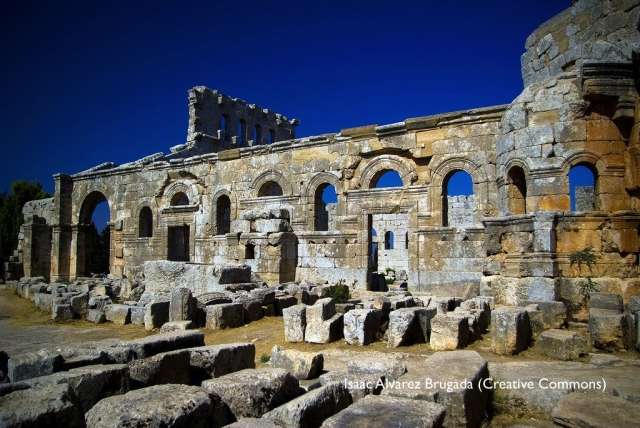By: Dorothy-Grace Guerrero*
Note: This article gives further context to the statement from Focus on the Global South last month concerning the proposed U.S. military intervention. The U.S.-Russia Syrian Accord reached in Geneva between U.S. Secretary of State John Kerry and Russian Foreign Minister Sergei Lavrov is progressing and the inspection of Syria’s chemical weapons has begun. We deem it important, especially for movements and Left groups in Asia, to understand the Syrian conflict and the revolution that is still happening there.
The revolution in Syria, similar to the uprisings in Tunis and Cairo, was a product of the Arab Spring in 2011. The uprising against the Assad regime began as a nonviolent expression of the aspirations that the Syrian people share with the people in the Maghreb and the Middle East: hurriya (political freedom), adala ijtima’iyya (social justice) and karama (dignity).
Two years after the series of momentous events celebrated worldwide as a sign of positive political change, the Middle East and the Maghreb are back in dire state of affairs. The democratically elected government of Mohamed Morsi was deposed through a coup d’état by a military-led alliance of Mubarak supporters, secularists, and oppositionists in Cairo. Key Tunisian opposition leaders of the Popular Front Coalition Chokri Belaid and Mohamed Brahmi were assassinated within five months in Tunis. People are now fleeing in droves from Libya, Mali, Yemen and Syria due to escalation of fighting and violence.
The Assad regime deliberately perpetrated state-sanctioned war crimes and crimes against humanity against civilians on a massive scale in order to survive.[i][ii][iii] The United Nations Commission on Human Rights and various human watch bodies estimate that the death toll in Syria would likely surpass 120,000. The Syrian Observatory for Human Rights breaks the numbers down into 37,000 civilians including 8000 women and children; 43,000 Assad regime military personnel including Special Forces; 13,539 rebel fighters; and 2,015 defectors from government forces[iv]. It is interesting to note that the government is in fact incurring the biggest loss. UN High Commissioner for Refugees reported that the number of refugees breached the two million mark[v].
Understanding the Assad regime and the Syrian Revolution
Western rhetoric is presenting the “Islamic” peoples as the enemies of the century. In the Syria crisis, there are two key elements at play: the violence being inflicted by the Assad regime on the Syrian people and the right to self-determination of the Syrian people.
Syria is in a complex situation but what’s happening there may also be viewed as part of the tumultuous birth of the modern Arab world, whose past is littered with bitter memories and characterized by poisoned relations between Muslim societies and the West. The current wars in the Middle East are still a consequence of European colonialism and imperialism.
The demise of the Ottoman Empire after World War I was followed by subsequent efforts to build a single pan-Arab state comprising of Arabic-speaking provinces. A United Arab Republic existed briefly, which embodied the spirit of secular Arab nationalism. What emerged later were state systems built by the British and the French that ensured the interests of these colonial powers while military coups rocked the region and single-party states dominated the political landscape. Syria’s post-colonial ruling elite after World War II continued to serve the interests of Paris and London.
The Assad family has ruled Syria, for four decades now since 1971. Hafez al-Assad, a military man, became Syria’s president following a bloodless coup. The Baath party, however, already ruled Syria even before Assad’s rise to power[vi]. Assad’s dictatorial hold on power strengthened the country’s military and intelligence forces. The most memorable but not isolated atrocity under his term was the 1982 Hama massacre, which targeted the Muslim Brotherhood party for its series of high-profile assassinations of leading Baathists. Hafez’s younger brother, Rifaat, carried out bombing campaigns as well as door-to-door operations, which resulted in nearly 40,000 deaths[vii]. The Assads’ power is so total and unchallenged that in order for the previously popular 34 year-old Bashar al-Assad to become president, the constitutionally required minimum age of 40 for the presidency was amended.
What is little known and hardly reported by the media is the fact that there is an ongoing revolution and various forms of resistances in Syria against the house of Assad. A dynamic, grassroots non-militarized resistance creatively opposes the Assad regime with popular support. Most reports and analysis focus on the concerns and positions of the U.S., UK, Saudi Arabia, EU, Israel and Iran, with very little effort to understand the various grassroots struggles being fought by the Syrian people.
Although the division in this war is largely understood as sectarian, ethnic and religious divisions are not total. The large minority of Syrians – the Alawites (a Shiite Muslim offshoot that includes President Assad and his most senior political and military associates), the Christians, and members of other minority communities; Baath Party loyalists and government employees; the professional armed forces and security services; and the (largely Sunni) crony capitalist class that the government has nurtured – still cling to the Assad regime. There are defectors to various dissident groups within all of these sectors, but altogether regime supporters’ number as much as one-third of the population.[viii].
The Alawites comprise around ten to twelve percent of the population. The majority of Syrians is Sunni Muslim and the poor majority is mostly aligned with the opposition groups. Other ethnic and religious minorities include Armenians, Christians, Druze, Palestinians, Kurds and Turkmens[ix]. Some prominent Christians and Sunnis support the Assad regime because they fear a future Islamist Syria[x]. There are radical Salafist and Jihadi groups. The jihadist groups, created by the Al Qaeda and Al Nusra, have their controlled regions and they even sell oil from those regions to the Assad government. Things are very complex and what is important to understand is that Al-Qaeda is actually not part of the revolution. It is in fact anti-revolutionary[xi].
The Arab Spring and the Syrian revolution are for the Arab world a second attempt to regain self-dignity after the colonial rule that subjected them to decades of humiliation. The Syrian resistance groups against Assad, like the Egyptian struggle, are a struggle against an oppressive regime. The poor that wanted to see reforms started Syria’s peaceful protests. Within a few months, the movement had to contend with violent terrorist operatives aligned with Al Qaeda and Al-Nasra, including extremist fighters from Lebanon, Turkey and Iraq. The jihadists are not fighting for a freed Syria, but to establish an ultra-fundamentalist state.
There are various initiatives. There is the National Coalition for Syrian Revolutionary and Opposition Forces (Syrian Coalition), which is a coalition of opposition groups, it was founded in Doha, Qatar, in November 2012. It includes Syrians from both inside and outside the country and bridges between the religious-secular divide[xii]. It is aiming to form an interim government that will take over once Assad is overthrown. There is also the Local Coordination Committees of Syria (LCCSyria), a network that supported civil disobedience and opposed armed resistance and international military intervention. They set up popular committees and mobilized the people for the 2011 protests. They believe that peaceful demonstrations will make it easier for the development of democracy following a revolution.
The Free Syrian Army, the armed opposition, is an informal network of defectors from the military. They support the demonstrators and are fighting on two fronts. On the one hand their enemy is the Assad regime, which must be overthrown as a necessary solution to the problems in Syria. On the other hand there are the jihadists groups. Added to the challenge are the influential regional powers Saudi Arabia, Iran, and Israel that has many different interests at play. Their interventions are making it more difficult for the revolutionary groups and their agenda to come to the fore as the dominant leaders of the struggle for freedom and emancipation.
The Conjuncture
The Syrian people are faced with the challenges of ending the war and the dictatorship of Assad and both are not easy. The reality under which the Syrians are living, their everyday resistance and the alternatives they want are being overshadowed by what is being played out in the global theatre.
Earlier in August, the U.S. wanted to intervene, in the name of the hundreds of thousands of lives lost and those that are suffering in Syrian prisons, through the use of military force to end the killings and violation of human rights. Despite its relative weakness now, the U.S. is still the biggest and most powerful military power on earth, with more than 1,000 military bases and the biggest military budget in the world. However, the events and positions of other key countries in September made it impossible for the U.S. to justify a military strike against Syria.
This loss of strength and to some extent face is being read as another manifestation of the U.S. decline. The lack of support from erstwhile allies was a worldwide opposition to the US’ strike and the demand for another solution to the conflict. The U.S. overstretched the justification to attack as the cases of the Gulf war, Kosovo, the Iraqi weapons of mass destruction and the threats of massacre in Bengazi, Libya come to memory of those that argued against it. There is a long list of US intervention in Latin America and Asia wherein military power was used to fight “enemies”. It is noteworthy how there is a more popular sentiment now about U.S. intervention as abuse of power. In his op-ed in The New York Times, Russian president Vladimir Putin said that he disagreed with Obama’s statement about U.S. exceptionalism. “It is extremely dangerous to encourage people to see themselves as exceptional.” [xiii] This op-ed was favorably received by people from a wide spectrum of positions, something unthinkable during the Cold War.
At the same time, the opposition within the U.S. has also been remarkable. As pointed out by Immanuel Wallerstein, this is the first time since 1945 that the U.S. government has been faced with this degree of internal opposition to such proposed action, especially in Congress, which heretofore has always almost routinely gone along. The opposition also comes from many different quarters for many different reasons, which is what makes it so powerful[xiv].
The events in the past months showed that there could be no resolution in the Middle East without significant pressure from the West such as the threat of attack. At the moment it seems that changes are be happening after interesting chess moves by key players: Presidents Barack Obama, Bashar al-Assad, and Vladimir Putin. Vigilance is needed to see where the U.S.-Russia brokered Syrian Accord will bring us. The Assad government now has a series of deliveries to do and deadlines to meet. First, a declaration of their chemical stocks, including names and quantities of chemical weapons agents, types of munitions, as well as where and how they are developed, produced and stored. Second, have these subjected to inspection by UN experts. And, third have a total disarmament by the middle of next year.
The Organization for the Prohibition of Chemical Weapons and the UN now have a team of 60 experts and support staff in Syria destroying Syria’s production facilities while the country’s civil war rages on. The Syrian civil war is likely to continue for a long time to come. This is where the relentless vigilance of people that wanted peace, and an end to war in Syria and the Middle East, should come in.
*Dorothy-Grace Guerrero is a Programme Coordinator of Focus on the Global South, she can be reached through [email protected]
[i] See Human Rights Watch, Torture Archipelago: Arbitrary Arrests, Torture and Enforced Disappearances in Syria’s Underground Prisons Since March 2011(New York: Human Rights Watch, July 3, 2012), www.hrw.org/reports/2012/07/03/torture-archipelago-0
[ii] Amnesty International, “Syria: Fresh evidence of armed forces’ ongoing crimes against humanity”, http://www.amnesty.org/en/news/syria-fresh-evidence-armed-forces-ongoing-crimes-against-humanity-2012-06-13
[iii] UNCHR, Report of the Independent International Commission of Inquiry on the Syrian Arab Republic, 04 June 2013 http://www.ohchr.org/Documents/HRBodies/HRCouncil/CoISyria/A-HRC-23-58_en.pdf
[iv] Jasiewicz, E., “Solidarity with Syria”, RedPepper Blog, 08 August 2013 http://www.redpepper.org.uk/solidarity-with-syria/
[v] “Number of Syrian Refugees Top 2 Million Mark With More on the Way”, UNCHR Syria Report, 03 September 2013 http://www.unhcr.org/522495669.html
[vi] Lesch, D., Syria: The Fall of the House of Assad, New Haven and London, Yale University Press, 2012.
[vii] Parvaz, D. “The Assads, An Iron-fisted Dynasty”, Aljazeera Online, 18 December 2012, http://www.aljazeera.com/indepth/features/2011/10/201110279954762656.html
[viii] Zunes, S. “Opposition to Intervention in Syria, Utilitarian Not Ideological”, OpenDemocracy, 23 September, 2012 http://www.opendemocracy.net/civilresistance/stephen-zunes/opposition-to-intervention-in-syria-utilitarian-not-ideological
[ix] Wood, P., “A Tour Inside Syria’s Insurgency”, The Atlantic, 29 December 2011, http://www.theatlantic.com/international/archive/2011/12/a-tour-inside-syrias-insurgency/250654/?single_page=true
[x] Komirredi, K. “Syria’s Crumbling Pluralism”, The New York Times, 03 August 2012, http://www.nytimes.com/2012/08/04/opinion/syrias-crumbling-pluralism.html?_r=1&
[xi] From Radio Interview of Yasser Munif, “Inside the Syrian Revolution and What the Left Must Do”, 10 September 2013, International Viewpoint Online Magazine, http://www.internationalviewpoint.org/spip.php?article3112
[xii] http://en.wikipedia.org/wiki/National_Coalition_for_Syrian_Revolutionary_and_Opposition_Forces
[xiii] Putin, V., “A Plea for Caution From Russia: What Putin Has to Say to Americans About Syria”, The Opinion Pages of The New York Times, 11 September 2013 http://www.nytimes.com/2013/09/12/opinion/putin-plea-for-caution-from-russia-on-syria.html?pagewanted=all&_r=0
[xiv] Wallerstein, I., “US Military Strike in Syria on Hold”, America Aljazeera Online, 15 September 2013 http://america.aljazeera.com/articles/2013/9/15/opposition-obamasyriamilitarystrike.html










